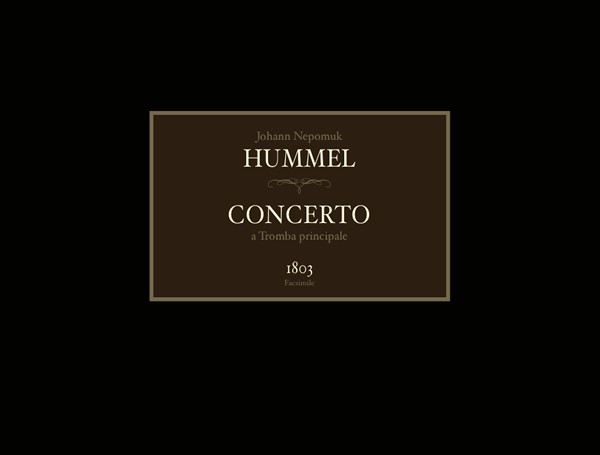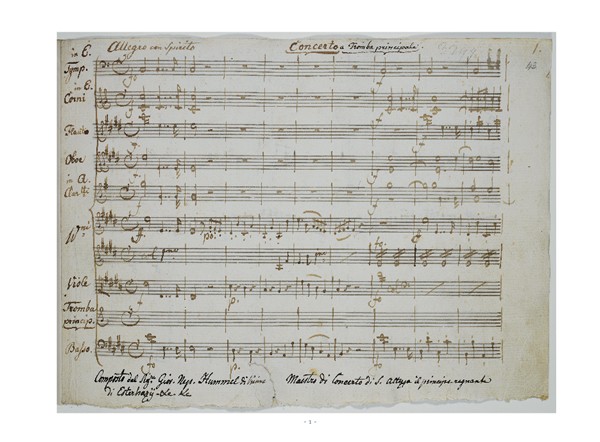


Johann Nepomuk Hummel, Concerto a Tromba principale, Facsimile edition with commentary (sold separately) by Edward H. Tarr, HKB Historic Brass Series 4 (Vuarmarens, Switzerland: Editions BIM, 2012). ISBN 978-2-88039-034-1 and ISBN 978-2-88039-036-5
The reviewer has before him a facsimile of one of the most well-known works for trumpet ever written: Johann Nepomuk Hummel’s Trumpet Concerto in E major of 1803, or simply “The Hummel” as most of us know it. It is safe to say, without any exaggeration, that if you are even remotely interested in the history and development of the trumpet that you must absolutely spend some time with this wonderfully-produced full-color facsimile and 20-page commentary. In fact, this publication demonstrates just how inaccurate the common wisdom about the work was before Edward H. Tarr gave the manuscript a fresh and thorough analysis.
I am greatly impressed with the quality of the facsimile itself. Of all the facsimiles I own, this is the one that makes me feel most like I am holding a piece of music history in my hands. The three layers of handwriting (original now-brownish ink, and later additions in red pencil and black ink) necessitated the full-color reproduction and also demonstrate the distinction with which the Editions BIM printers went about their work. Even more impressive is the inclusion of the original fold-out pieces of paper used for corrections – the publisher has taped them in exactly where they are in the original. I have to admit that at times these fold-outs made me feel like a baby holding a pop-up book, so eager was I to see what was underneath. I have only one real criticism for the facsimile portion: for some reason the publisher inserted small red measure numbers on the top corner of each page within the margins of the facsimile. I can understand the interest in numbering the measures for reference’s sake, but they should have been placed outside of the margin so as not to interfere with the original.
The separately-sold 20-page commentary booklet accompanying the facsimile provides all the necessary information for understanding the historical details of the manuscript and its implications for the modern performer of “The Hummel.” Most of the commentary deals with the substantial changes made to the trumpet part in black ink and red pencil. Tarr provides a convenient modern transcription of each of the three versions – original brown ink, black ink changes, and red pencil changes – making for an easy examination of the work’s evolution and performance possibilities. There are other insights into the false assumptions made by modern editions of the work as well. For instance, the mysterious “wavy lines” seen in the Concerto have usually been interpreted as trills, but Tarr notes that these lines differ from the composer’s usual marking for trills. He posits that the marking indicates a heavy vibrato instead. Taken in generally, Tarr’s notes make it clear that every single edition of the Concerto ever printed has errors, some more serious than others. Undoubtedly Editions BIM will print a modern urtext version in the near future, which should rectify this problem once and for all.
I am somewhat less enthusiastic about Tarr’s discussion of Hummel’s use of musical quotations within the work. He and others (notably John Rice in an article in Music and Letters) have argued for a significant number of borrowed thematic ideas within the work from Cherubini and Mozart, as Hummel worked to increase the accessibility and popularity of his concerto. To me the presumed references to Mozart seem more like topical similarities (further see the writings of Leonard Ratner). If Hummel really is quoting throughout, it would fundamentally change the way in which we think about this composition. Perhaps Tarr is correct and these quotations are there and were intentional, but I remain skeptical. To me these gestures are compositional clichés typical of the style of the time, though the discussion of the E major tonality of the work may hold more water. The remainder of the commentary includes biographical details, an examination of the different handwritings seen in the facsimile, and a discussion of the performance history of the work.
In spite of these few and admittedly nitpicking problems, overall the facsimile edition is a must-own for the aspiring trumpet historian and will provide even the average trumpet player with a great deal of food for thought. Those that teach trumpet at the college level will find this to be a useful and engaging resource for instruction – especially as students prepare the work for performance in recital. The pair of books are reasonably priced at a combined ~$110, which is less than equivalent facsimiles I have purchased in the past. In summation, it is a shame that we had to wait some 200 years for this publication, but now that we have it we should all have a copy on our bookshelf.
-- Bryan Proksch



